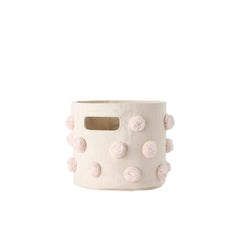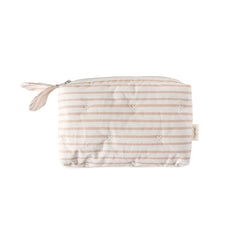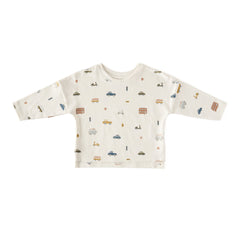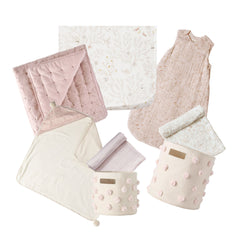When your little one is well-rested, life is a whole lot easier. So, it’s not surprising that many new parents are looking for tips and tricks to ensure success when it comes to naps and bedtime. There are a number of different factors at play when it comes to your baby’s sleep routines and clothing is an important piece of the sleep puzzle. If you’re wondering how to dress baby for sleep in winter, you’ve come to the right place! In this article, we’ll walk you through everything you need to know about how to dress a newborn in winter and share a few of our winter sleep must-haves. We have a feeling that peaceful winter nights are in your future.
Table of Contents
- Why it’s important to know how to dress baby for sleep in winter
- What temperature should a baby’s room be?
- How to dress baby for sleep in winter
- How do I know if my baby is too warm?
- What should I do if I think my baby is overheating?
- How can I tell if my baby is too cold?
- What should I do if I think my baby is too cold?
- How to dress a newborn in winter: sleep essentials
Why it’s important to know how to dress baby for sleep in winter
Many first-time parents wonder why so much emphasis is placed on sleep outfit selection. There is a great reason for this and it relates to your baby’s health and safety. Babies can’t regulate their body temperatures as effectively as older children and adults. This is because a newborn's body surface-to-weight ratio is about three times greater than an adult’s. This means that they can both lose heat and overheat very quickly. This is especially true if your little one was born prematurely or at a low birth weight. However, even full-term newborns are unable to maintain their body temperature if the environment around them is too hot or too cold. In fact, they lose body heat about four times faster than adults! What’s more, they’re unable to shiver like we do to increase their body temperature when it drops below the normal range. When this happens, it can impact their breathing and their body’s use of oxygen. That’s why it’s so important to know how to dress baby for sleep in the summer and winter months.
What temperature should a baby’s room be?
The ideal temperature for baby’s room may vary slightly from one child to another. These variations relate mostly to what type of climate your newborn is accustomed to. However, although there may be slight differences in the ideal temperature for a baby’s room, it’s recommended that nursery rooms are kept between 68 to 72 degrees Fahrenheit or 20 to 22 degrees Celsius. This temperature range is ideal because it helps your little one maintain a healthy body temperature and allows them to sleep peacefully while still waking up to auditory signals. This helps decrease the chance of Sudden Infant Death Syndrome (SIDS).

Magical Forest 1.7 TOG Sleep Bag & Sleeper
How to dress baby for sleep in winter
If you’re wondering how to dress a newborn in winter, you’re not alone. Many new parents are unsure what sleepwear is appropriate for their little ones as the temperature begins to drop outside. Here are a few key things to keep in mind:
- Dress your baby for the temperature indoors, not the temperature outdoors. Many parents think that because it’s cold outside they should bundle their little one up for sleep, but this can result in overheating.
- A good rule of thumb to help guide you when you’re dressing your baby for sleep is to add one extra layer of clothing more than you would typically wear in the same temperature.
- If the temperature in your little one’s room is dropping overnight, add one extra layer to help them stay warm. This could be a sleep bag or a swaddle. You could also try out pajamas with covered feet. If you’re adding one more layer of clothing than you normally would, keep an eye out for any signs that your baby is overheating.
- Keep in mind that it’s better to have your baby slightly underdressed, rather than heavily overdressed, so don’t add more than one layer at a time.
- Make sure you have a thermometer in your baby’s room, so you can get a sense of how the temperature is fluctuating overnight and whether or not your heating or cooling system is maintaining a steady climate.
- Skip the hat, even in the winter months. Putting a hat on your little one overnight can be a safety hazard, as it can easily slip off your baby’s head. It may also contribute to overheating.
- Remember, you know your baby best and every child is different. Use your judgment when dressing your little one for bed.
How do I know if my baby is too warm?
The best way to determine if your child is overheating is to take their temperature. There are also a number of other easy-to-spot signs you can look for. Here are some key indicators that your baby is overheating:
- They feel warm to the touch
- Their skin is red or flushed
- They’re nauseous or vomiting
- They have an elevated heart rate
- They’re acting tired or sluggish
- They appear to be confused, disoriented, or dizzy
- They’re sweating or have damp hair
What should I do if I think my baby is overheating?
If you’re worried that your baby is overheating, there are a few things you can do to help reduce their body temperature:
- Remove your baby’s clothing
- Take them to a cooler location if possible
- Offer your baby fluids (breastmilk, formula, or a glass of water if they’re old enough)
- Give your baby a sponge bath with lukewarm water
How can I tell if my baby is too cold?
Just like overheating, babies show signs of distress that are easy to spot when the temperature in their nursery is too low. A baby who’s too cold will give you some warning signs that their body temperature is not quite right.
Here are some key indicators that your baby’s body temperature is dropping below a normal range:
- They become sluggish or unresponsive
- Their cry is weaker than usual
- Their skin is pale and cold to the touch
- They’re having trouble breathing
- They’re not feeding
What should I do if I think my baby is too cold?
If you suspect that your baby is too cold, here are a few things you can do right away to try and warm them up:
- Add additional warm layers of clothing
- Use your own body heat by holding your baby close to you. You can also drape a blanket over them, but never leave them unsupervised with the blanket.
- You may also want to try swaddling your baby

How to dress a newborn in winter: sleep essentials
Sleep essentials are an important part of any list of nursery must-haves. You’ll find many of the below items in our baby clothing holiday gift guide. They’re perfect for all the little ones on your list this year.
- Swaddles. Many parents swaddle their newborn babies until they’re about 3 months old. From there, swaddles can grow into blankies, lovies, sun shields, and blankets they’ll reach for again and again. We suggest stocking up on these for winter to help keep your little one cozy and warm.
- Sleepers are the perfect pajamas for the first 0 - 12 months of your baby’s life, as the covered feet will help keep them toasty all night long. You’ll definitely find these cozy pieces in your holiday gift guide.
- 1.7 TOG Sleep Bag. The perfect sleep bag to help them snooze all night long actually does exist. We think it should be on every holiday gift guide for 2022. Our Sleep Bags are designed for baby's comfort and your peace of mind with underarm snaps to ensure a perfect fit as your child grows. This Sleep Bag is 1.7 TOG is the perfect weight to keep baby snug all year round
- Crib Sheet Temperature regulation isn’t just related to what your baby is wearing. What they sleep on is important too. This breathable and soft crib sheet will help your little one have the perfect night’s sleep.
Many first-time parents worry about how to dress baby for sleep in the winter. But, with a few key pieces of knowledge and some winter sleep essentials, both you and your baby are sure to have lots of restorative sleep!






